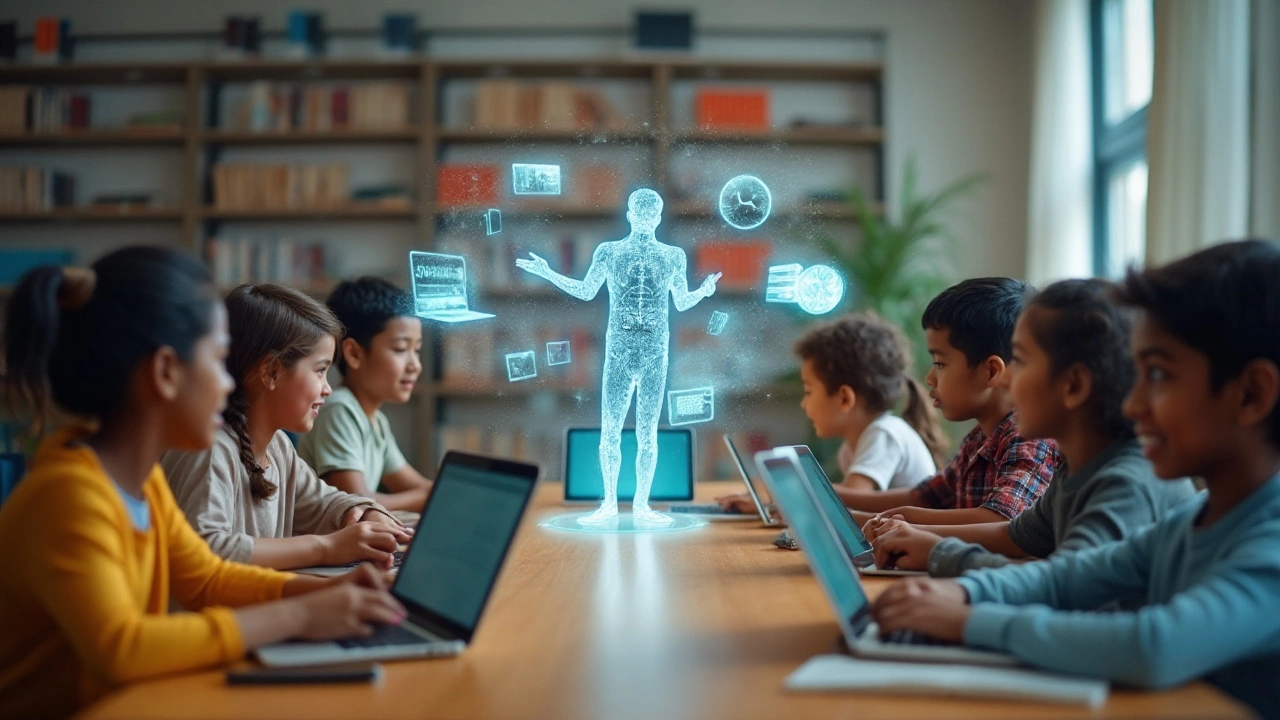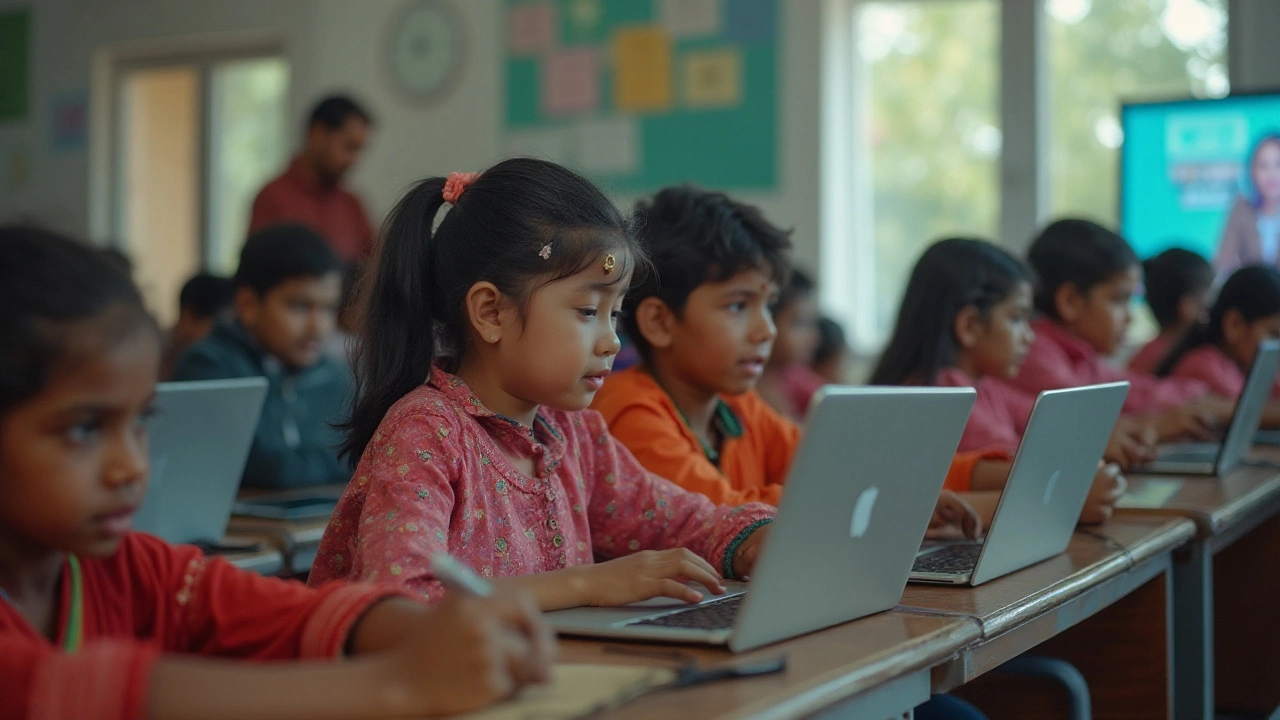Digital learning platforms have been at the forefront of a revolution in education, reshaping how knowledge is delivered and absorbed. With the click of a button, students can explore diverse subjects, guided by expert educators from across the globe.
These platforms come equipped with interactive tools, enabling users to engage with materials in a way that suits their learning style. As we delve deeper into the world of digital learning, we uncover both the vast potential and the hurdles that come with this technological advancement.
From fostering greater inclusivity in education to adapting to various learning needs, digital platforms are making education more accessible. However, it is essential to understand their intricacies to harness their full potential. Dive in as we explore what makes these platforms tick and how they are revolutionizing education.
- What Defines a Digital Learning Platform?
- A Brief History of E-Learning
- Features and Tools of Modern Platforms
- Advantages of Digital Learning
- Challenges and Considerations
- The Future of Digital Learning Platforms
What Defines a Digital Learning Platform?
At its core, a digital learning platform is an online-based solution designed to facilitate the delivery of educational content in an organized and interactive manner. These platforms bring together technology and expertise to create a virtual space where teaching and learning can thrive. A robust digital learning platform not only provides access to a plethora of courses but also offers various tools that enhance the learning experience. These may include forums for discussion, interactive quizzes, and multimedia content that aids in comprehension.
One key aspect that sets digital learning platforms apart is their flexibility. Unlike traditional classroom settings where the pace and schedule are often rigid, these platforms allow students to learn at their own speed. This has opened avenues for millions of learners worldwide who might have schedules that don’t fit the traditional schooling system. The integration of analytics tools further aids educators in tracking students’ progress, enabling them to tailor content to specific needs, which enhances the overall effectiveness of learning.
In the world of digital learning, the e-learning platforms each bring their unique flair and focus. From platforms like Coursera and EdX offering university-level courses to Khan Academy’s K-12 focus, there is something for every learner. The versatility of these platforms allows them to cater to both academic pursuits and professional development. According to a report by GlobalMarketInsights, the e-learning market surpassed $250 billion in 2022 and continues to grow at a rapid pace, underscoring its importance in today's educational landscape.
While exploring the importance of digital learning platforms, one cannot ignore their ability to make education inclusive. By breaking geographical barriers, these platforms ensure that learners from various corners of the world can have equal access to quality education. This global reach not only enriches the learning experience with diverse perspectives but also democratizes knowledge distribution.
As Lincoln Daley, an education technologist, aptly puts it, "Digital learning platforms have shifted education from a one-size-fits-all model to a personalized and inclusive practice, connecting learners with opportunities they never thought possible."
Given these capabilities, digital learning platforms are equipped to handle a range of educational tasks and objectives. From providing platforms for MOOCs (Massive Open Online Courses) to hosting smaller, more targeted training sessions, they cover a broad spectrum of educational needs. With technology ever-evolving, the future potential of these platforms is boundless, making them an integral part of both formal and informal education systems globally.
A Brief History of E-Learning
The journey of digital learning platforms has its roots in the burgeoning era of computers and the internet. E-learning, as it is widely referred to, began its evolution in the late 20th century with the advent of computers penetrating classrooms and workplaces. During the early 1960s, educational institutions started experimenting with computer-based training programs, laying the groundwork for a shift in educational methodologies. It was a time of tremendous innovation as educators and programmers tried to utilize technology to enhance learning experiences and reach a wider audience beyond the conventional classroom.
By the 1980s, advancements in computer technology saw the introduction of CD-ROMs, which enabled rich multimedia content to enrich the learning process. Universities and corporate organizations began using these disks to distribute educational material, promoting self-paced learning among students and employees. It was around this time that programs were developed which could run on personal computers, allowing students greater flexibility in when and how they learned.
The true revolution, however, occurred with the rise of the internet in the 1990s. Institutions worldwide began offering online courses, and the term "web-based learning" became part of the educational lexicon. This period saw the establishment of pioneering online learning platforms like Blackboard and Moodle, which provided tools and solutions for hosting and managing online courses. The internet opened up a frontier of possibilities, making online education accessible to millions globally, transcending geographical barriers.
With the turn of the century, the explosion of broadband internet connections, combined with powerful new software tools, further pushed the horizons of digital learning. As internet speeds increased and video streaming became seamless, platforms ventured into offering live lectures and interactive sessions, mimicking in-person classroom dynamism. According to a study by the Sloan Consortium in 2003, over 1.9 million U.S. students were enrolled in online courses, doubling the numbers from the previous year, and sparking a global trend.
The 2010s saw the onset of the Massive Open Online Course (MOOC) phenomenon, with platforms like Coursera, edX, and Udacity leading the charge. MOOCs brought a democratic approach to education, offering world-class courses to anyone with internet access, often for free. This decade marked significant progress not just in quantity but in the quality and interactive nature of digital learning experiences. One esteemed educator put it succinctly:
"E-learning is not just a tool, but our gateway to reshape education as we know it."
In recent years, equipped with advances in machine learning and artificial intelligence, modern platforms have integrated personalized learning pathways that dynamically adjust to fit individual learning speeds and styles. As we navigate this digital learning landscape, it's fascinating to observe how these platforms continually adapt, serving the ever-changing educational needs of a diverse global community. As statistics from Class Central suggest, by 2023, MOOCs had over 220 million learners, demonstrating the massive impact of this education revolution, a testament to the endless possibilities of e-learning platforms.

Features and Tools of Modern Platforms
Modern digital learning platforms are equipped with a host of innovative features and tools designed to enhance the learning experience. At the core of these platforms is their Learning Management System (LMS), a software application that administers, documents, tracks, and delivers educational courses or training programs. With the LMS, educators can create a structured learning path where learners progress through lessons at their own pace. One interesting feature is the integration of multimedia content. These platforms support videos, podcasts, and interactive modules, making learning engaging and dynamic, unlike traditional textbooks.
Moreover, many platforms include analytics and reporting tools, which are invaluable for both learners and educators. These tools track a student's progress and performance over time, highlighting strengths and areas needing improvement. This data-driven approach allows for a personalized learning experience tailored to the needs of each student. To further bolster personalized education, some platforms feature Artificial Intelligence (AI) capabilities that adapt to the student’s learning style and pace. For instance, platforms like Coursera and Khan Academy employ AI to recommend additional resources based on a student's performance and interests.
A unique aspect of modern e-learning platforms is their focus on community and collaboration. Many platforms are equipped with virtual classrooms that simulate traditional classroom environments, complete with audio-visual capabilities for live interactions. Students and educators can participate in discussions, collaborate on projects, and engage in peer feedback sessions, thus enriching the learning experience. These features mimic in-person learning, making remote education a more holistic and integrated experience.
"Creating a classroom beyond borders is about bridging the gap between availability of knowledge and accessibility," says Dr. Linda Darling-Hammond, President of the Learning Policy Institute.
Furthermore, online education is made even more interactive through gamified learning experiences. Many platforms incorporate game-like elements such as quizzes, badges, and leaderboards to motivate students. This method has been shown to increase engagement and retention rates, making learning both fun and effective. By transforming learning into an enjoyable activity, students are more likely to stay committed and achieve their educational goals. Additionally, role-playing scenarios and simulations provide hands-on experience, preparing students for real-world applications.
Support and accessibility are also key considerations in these platforms. Customer support is often provided through chatbots for quick query resolution, and comprehensive FAQ sections or help centers offer detailed guides. Accessibility features, including text-to-speech, captioning, and translation services, ensure that learning is inclusive and available to individuals with diverse needs. With these myriad features, digital learning platforms are paving the way for a more inclusive, engaging, and efficient educational landscape.
Advantages of Digital Learning
The realm of digital learning offers a multitude of benefits that are reshaping education as we know it. One of the most striking advantages is the ability to transcend geographical barriers. With online platforms, students from any corner of the globe have access to a wide array of courses and resources. This democratization of education allows learners to tailor their learning experiences according to their needs, schedules, and preferences, without the constraints of physical classrooms. Digital platforms often offer flexible learning options, making them ideal for working professionals or students with other commitments.
Another compelling benefit is the personalization of education. Digital learning platforms often employ sophisticated algorithms to assess a student's performance, allowing them to recommend tailored content that addresses individual strengths and weaknesses. Such personalized feedback is invaluable in helping learners progress at their own pace. Moreover, interactive elements such as quizzes, gamified lessons, and virtual labs engage users more effectively than traditional learning environments. These tools ensure that students remain motivated and involved in their education.
One cannot overlook the financial feasibility of e-learning platforms. Traditional education can be costly, with expenses such as tuition, accommodation, and transportation. In contrast, online learning often proves more economical, offering similar, if not superior, quality education at a fraction of these costs. Students also benefit from a plethora of free resources, including lectures, forums, and peer interactions, which complement their learning journey. Supporting this, a study from the Babson Survey Research Group indicated that in 2023, over 30 percent of higher education students in the U.S. were enrolled in at least one online course, showcasing the rising adoption of digital learning.
"E-learning is cost-effective and provides students with access to a world-class education without the heavy financial burden associated with traditional universities." – Lizzie Snow, Education Technology Specialist
Furthermore, in a world that's continuously evolving with technology, digital learning platforms equip learners with essential skills for the digital age. Whether it's through courses in coding, data analytics, or digital marketing, students can gain practical knowledge that is directly applicable in the modern workforce. This not only increases employability but also enables students to stay ahead in an increasingly competitive job market. Institutions are capitalizing on this trend by offering micro-credentials and certificates that validate a learner's skills and proficiency.
The adaptability and accessibility of digital learning platforms, coupled with technological advancements, make them an invaluable part of modern education. Today, harnessing the power of technology has become not just beneficial but essential. As these platforms evolve, they continue to revolutionize the educational landscape, ensuring that learning is an engaging, personalized, and enriching experience for every student.

Challenges and Considerations
As digital learning platforms continue to develop, they face a number of challenges that both educators and learners must consider. One major hurdle is ensuring equitable access to technology. In many parts of the world, access to reliable internet and devices remains inconsistent, creating a digital divide. This can lead to unequal learning opportunities and outcomes, particularly for students in underprivileged or remote areas. It's crucial that we find ways to bridge this gap and make digital learning more inclusive for everyone.
Another pressing issue is maintaining student engagement in a virtual setting. The online environment offers a myriad of distractions not found in traditional classrooms, making it difficult for learners to stay focused. Educators often need to develop creative strategies to keep students engaged, such as interactive activities or gamification elements. Besides, without the physical presence of a teacher, students may find it challenging to stay motivated and disciplined in their studies.
There is also the concern of data privacy and security on these e-learning platforms. As students engage with digital tools, they often share personal information that needs to be adequately protected. Institutions and platform developers must prioritize stringent data protection measures to safeguard users from breaches, which can undermine trust in digital education solutions.
"We must ensure that the promise of digital learning is fulfilled responsibly, with an eye on accessibility and security for all," says a spokesperson from UNESCO.
Moreover, technology's rapid evolution presents its own set of challenges. Keeping educational content and tools up to date with the latest technological advancements requires continuous investment in both time and resources. Educators also face the task of continuously updating their skills to effectively leverage new technologies in their teaching methods, from virtual classrooms to AI-driven personalized learning tools.
Finally, evaluating the efficacy of digital education remains a complex challenge. Traditional assessment methods may not translate well into the digital realm, necessitating the development of new, effective ways to measure student performance and learning improvement. It's essential for education stakeholders to collaborate and refine evaluation techniques to ensure they provide meaningful insights.
The Future of Digital Learning Platforms
As we peer into the future of digital learning, one can sense an era poised for dynamic and innovative changes on a global scale. Driving these changes is the steady advancement of technology. Developments in artificial intelligence, augmented reality, and virtual reality are all seeping into the educational space, creating more interactive and immersive learning experiences. Imagine a chemistry class not bound by textbook presentations, but one where students can virtually walk through molecular structures or conduct experiments in a virtual lab. Such possibilities are no longer in the realm of science fiction, but a part of our evolving reality. This transformation is marked by the ability to tailor learning experiences to the unique pace and style of each individual learner, moving away from the one-size-fits-all approach.
Moreover, the surge in mobile technology plays a pivotal role in making e-learning platforms more accessible to a broader audience. The proliferation of smartphones and tablets means educational content can be accessed anytime, anywhere. This is particularly impactful for remote or underrepresented communities where traditional educational resources might be scarce. According to a report by UNESCO, mobile learning could potentially reach 70 million children who might otherwise never enter a classroom. Such statistics illuminate the transformative potential of integrating technology into education.
"The future of education technology is about adapting digital tools and platforms to offer connectivity that bridges gaps in education," says Samantha Adams Becker from EdTech Magazine.
In addition, the importance of collaboration between governments, educational institutions, and tech giants can't be overstated. Collaborative efforts are essential to ensure that technology solutions are effectively incorporated into existing educational infrastructures. As the world anticipates increased connectivity through the rollout of 5G networks, real-time collaboration will become more seamless. Imagine a class project where students from Vancouver collaborate with peers in Nairobi, exchanging ideas and cultural insights effortlessly through a virtual classroom setup. Such integration fosters not just academic growth but also cross-cultural understanding, shaping a truly global learning community.
Challenges, naturally, accompany these innovations. Data privacy and security remain critical concerns as information flows through digital channels. Institutions will need to establish robust cybersecurity measures to protect users' data. Meanwhile, educators will need upskilling to remain ahead of technological advancements and utilize these tools effectively. Initiatives for continues professional development in digital strategies will become a norm, ensuring that the educators themselves are not left behind in this technological wave.
Emerging Technologies to Watch
Several cutting-edge technologies stand at the forefront of educational transformation.
- Artificial Intelligence (AI): AI has the capability to analyze vast amounts of data to provide predictive insights into student learning behaviors, helping educators design personalized learning paths.
- Blockchain: Beyond cryptocurrencies, blockchain can bring about secure and immutable academic records, simplifying the verification of credentials and certificates.
- Gamification: By incorporating game-like elements into education, these platforms are making learning engaging and fun, motivating students through rewards and competition.
As we conclude this journey through the potential of digital learning platforms, it becomes evident that the blend of technology and education is paving paths that were unimaginable just a decade ago. The old proverb, "a world to win," takes on new meaning as digital platforms knock down educational barriers, creating spaces for learning in ways that are as diverse as the learners themselves. As we stand on the brink of these exciting prospects, embracing innovation while addressing the accompanying challenges will be crucial for educators and learners alike in this ongoing educational evolution.



